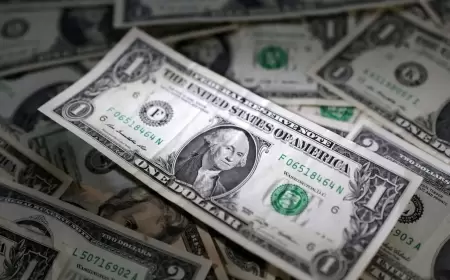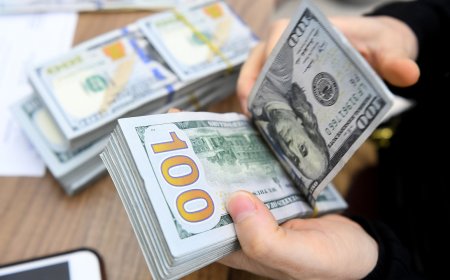Forex Dollar's impressive rise against the yen ahead of crucial CPI Data
Read about the dollar's impressive rise against the yen ahead of crucial CPI data. Explore the PBOC's efforts to bolster the yuan and its impact on global markets.

The Forex dollar achieved a significant milestone by surpassing 144 yen on Thursday, marking a one-month peak. The focal point of investor attention was the evident divergence in monetary policies, with the anticipation of pivotal U.S. inflation data looming large. This data is expected to cast a deciding influence on the future trajectory of interest rates.
Simultaneously, the yuan orchestrated a modest recovery, breaking away from its one-month low. This resurgence was attributed to the People's Bank of China (PBOC) issuing a mid-point guidance rate that surpassed market expectations. The move signifies the PBOC's unease with the recent weakening of the currency. This shift positively impacted other currencies as well, such as the Australian and New Zealand dollars, which bounced back from their near two-month nadirs.
The dollar's ascendancy reached an impressive 144.08 yen, a level unseen since July 7. Market sentiment inclined toward the belief that the Bank of Japan (BOJ) would exercise caution in its approach to stimulus tapering. This sentiment persisted despite the prevailing consensus among traders that the U.S. Federal Reserve had drawn the curtains on its rate hikes.
Another contributing factor to the yen's predicament was the escalation in crude oil prices to levels unseen since January. This occurrence is of significance as Japan, a nation heavily reliant on oil imports, faces a substantial impact from this upward trend in oil costs.
Market analyst Tony Sycamore from IG noted, "The fact that energy prices have risen for almost seven weeks, that's certainly weighed on the yen."
The prospect of breaching the 145 yen mark could potentially pave the way for an ascent towards 148. Tony Sycamore speculated that this scenario could unfold following the release of the CPI data.
Despite the Bank of Japan's recent policy shift that eased its grip on long-term yields, experts argue that this adjustment was primarily a technical maneuver aimed at extending the longevity of stimulus measures. These measures predominantly encompass the imposition of a negative short-term interest rate.
Kristina Clifton, a strategist at the Commonwealth Bank of Australia, highlighted, "Weak Japanese labor cash earnings data earlier this week has increased our conviction that the BOJ will leave interest rates unchanged at -0.1% over the rest of the year."
Analysts underscore that the diverging trajectories of monetary policies between the U.S. and Japan paint a picture of continued support for USD/JPY.
As the financial world eagerly awaited the impending CPI data release, the dollar's interactions with other currencies remained relatively muted. The U.S. dollar index, a benchmark gauging the dollar against a basket of six major counterparts, including the euro and sterling, exhibited minimal movement around the 102.50 level during the Asian afternoon trading session. This position aligned closely with the midpoint of its trading range for the week, which oscillated between 101.98 and 102.80.
In comparison to the preceding Friday, the index demonstrated a 0.5% appreciation, positioning itself for its fourth consecutive weekly gain.
Amidst a series of subpar economic indicators from China, the dollar capitalizes on its reputation as a safe-haven asset. Furthermore, the narrative continues to solidify, suggesting a soft landing for the U.S. economy as inflationary pressures show signs of abatement.
Prominent Wall Street economists have forecasted a consistent year-on-year rise of 4.8% in the core consumer price index (CPI) for the month of July, mirroring the previous month's figures.
Money markets currently estimate an 86.5% likelihood that the Federal Reserve will abstain from further rate hikes during its September meeting. The prevailing sentiment anticipates the next move to be a rate cut, potentially occurring in the spring of the forthcoming year.
Recent data revealing China's economy slipping into deflation last month has further bolstered the dollar's appeal as a safe haven. This trend was compounded by a report indicating a significant downturn in both imports and exports.
Conversely, the offshore yuan exhibited a modest resurgence, achieving a rate of 7.2246 per dollar. This marks the second consecutive day of positive momentum, attributed to the PBOC's decision to establish an official mid-point rate that exceeded market expectations. This shift comes after the offshore yuan hit its weakest point since July 7 on Tuesday, recording a rate of 7.2514.
The Australian dollar, often influenced by yuan trends, managed to post a 0.15% recovery, settling at $0.65385. This rebound followed a trough of $0.6497 on Tuesday, a level not observed since June 1.
In tandem, New Zealand's kiwi registered a 0.1% surge to $0.6058, regaining ground after plummeting to a low of $0.6035 on Tuesday, its lowest point since June 8.
Explore More Articles Like These:






























































